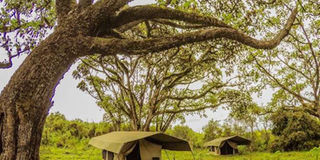Search for black leopard in Aberdares

I got a call from a South African friend asking about the chances of finding a melanistic leopard in the Aberdares. There is lots of anecdotal evidence suggesting these ‘black panthers’ roam these mountains. I set about doing some research. PHOTO | ANDREAS FOX
What you need to know:
- An animal with melanism has a genetic condition that manifests as an overproduction of black pigment, melanin. It is more common in some animals than others.
- Determined to see one, three South Africans came to Kenya and joined me for a week. I booked the KWS Hargenia Special Campsite, a few kilometres north of the Chania Falls.
- Despite giving it our best shot, we never saw a melanistic leopard. I think KWS should attempt to get a photograph, even if it’s from a camera-trap, or run an appeal for pictures from visitors. Proof will definitely attract intrepid tourists like my South African friends.
I got a call from a South African friend asking about the chances of finding a melanistic leopard in the Aberdares. There is lots of anecdotal evidence suggesting these ‘black panthers’ roam these mountains. I set about doing some research.
An animal with melanism has a genetic condition that manifests as an overproduction of black pigment, melanin. It is more common in some animals than others; there is a black Augur buzzard breeding a few gardens away from my home in Lavington, for instance. In leopards, genets and servals, these animals look pitch black but, in the right light, the spots are still visible.
Most reports of black leopards come from places such as the rainforests of Asia. In Africa, they occur in the Aberdares, Mount Kenya, the Mathews Range, as well as around Lydenburg, South Africa, and in the Ethiopian highlands.
The more I asked, the more my focus turned to the Aberdare moorlands, specifically in the area around the Fishing Lodge. I kept hearing of sightings but, crucially, there were no photographs.
Determined to see one, three South Africans came to Kenya and joined me for a week. I booked the KWS Hargenia Special Campsite, a few kilometres north of the Chania Falls. This has to be one of the most amazing campsites I have ever come across, shaded by a grove of beautiful Hagenia abyssinica trees.
SPECIAL CREATURES
We got African Outdoor Safaris to set up camp and cater. Their great value camp consisted of basic walk-in tents with proper beds, separate bucket-showers and toilet tents, a “mess” and a self-contained kitchen. Their two fantastic staff prepared fresh food, kept the showers hot, and ensured the camp ran like clockwork as we eked out every possibly moment in field tracking and searching for the elusive cat.
Over the week we must have driven every road in the moorlands. It truly is spectacular, with rolling plains of tussock grass, patches of forest draped in “Old Man’s Beard”, endemic Groundsels and crisscrossed with crystal clear streams, punctuated with waterfalls.
And if that isn’t enough temptation, we saw buffalo, hyena, waterbuck and bushbuck everyday. The special Jackson’s francolin, Black-fronted duiker and Bohor reedbuck were all regularly seen too. A day trip down into the forested salient featured two “regular” leopards, elephants and giant forest hogs.
Then there are the really special creatures. We ended up having 10 several sightings, five of which were melanistic. We once had to do a double take as we were convinced one was a leopard. We also saw the endemic Aberdare cisticola, found nowhere else, and a pair of zorillas.
Another attraction of the moorlands is the relative freedom to get out of your vehicle. I recommend that you get a KWS ranger to escort you for longer walks. However, in the open areas, for the waterfalls or for trout fishing, it is quite safe — just look out for buffalo.
We took advantage of this and looked for any signs of leopard. We even enlisted the help of the rangers at the Kiandogoro Gate. They say they had personally seen black leopard twice this year but said that lots of reported sightings were likely to be mistaken black servals.
Despite giving it our best shot, we never saw a melanistic leopard. I think KWS should attempt to get a photograph, even if it’s from a camera-trap, or run an appeal for pictures from visitors. Proof will definitely attract intrepid tourists like my South African friends.
Staying in the moorlands is not as easy at the moment, however. I would recommend a 4x4 with low-range in the rains. The public Reedbuck campsite, adjacent to Fishing Lodge, has basic facilities. Prepare for a cold night though!
DONKEY BOILERS
The Fishing Lodge itself is a favourite spot for many. Its two units can squeeze seven people each and are booked out exclusively. There is a gas cooker and it has all the crockery, etc. You only need to bring food and firewood. There is a caretaker who is supposed to heat water for showers. However, elephants have destroyed the ‘donkey-boilers’, apparently while searching for ash to supplement their diets. It costs Sh14,000 to book a unit. I would dread the idea of a cold shower up there though!
Then there is the Sapper Hut, perched along the Magura River, right by a beautiful waterfall. It has two beds, a fire-place and donkey boiler. It strikes me as the ideal spot for fishing or for adventurous, seriously romantic couples. Unfortunately, it is in a sad state and has been overrun by bees. With a little bit of attention, KWS can turn Fishing Lodge and Sapper Hut into two of the most desirable and good value self-catering options in the country. If Sapper Hut is repaired, I will be right back up there looking for that leopard.
Information: African Outdoor Safaris: [email protected] or 0722606303





